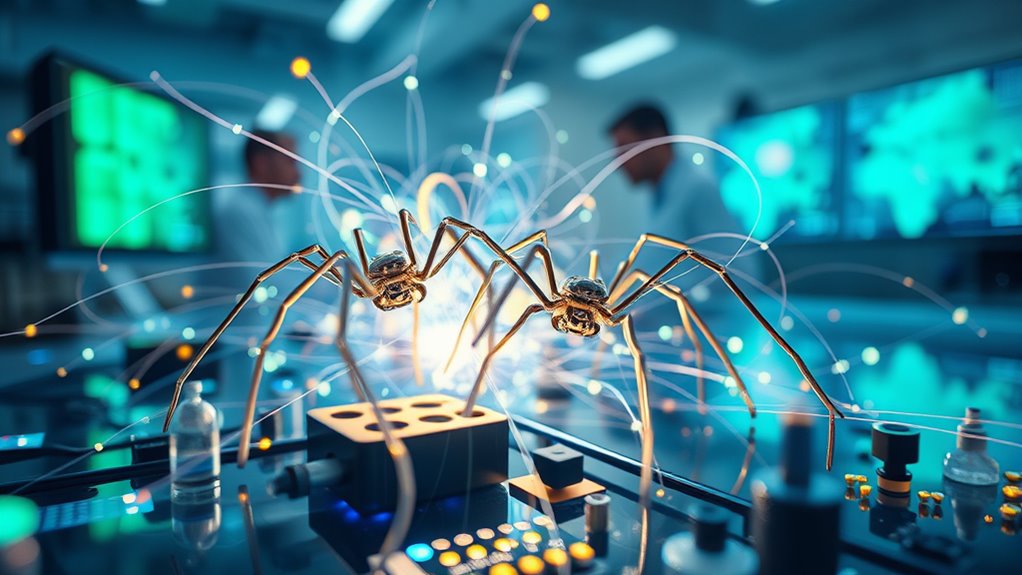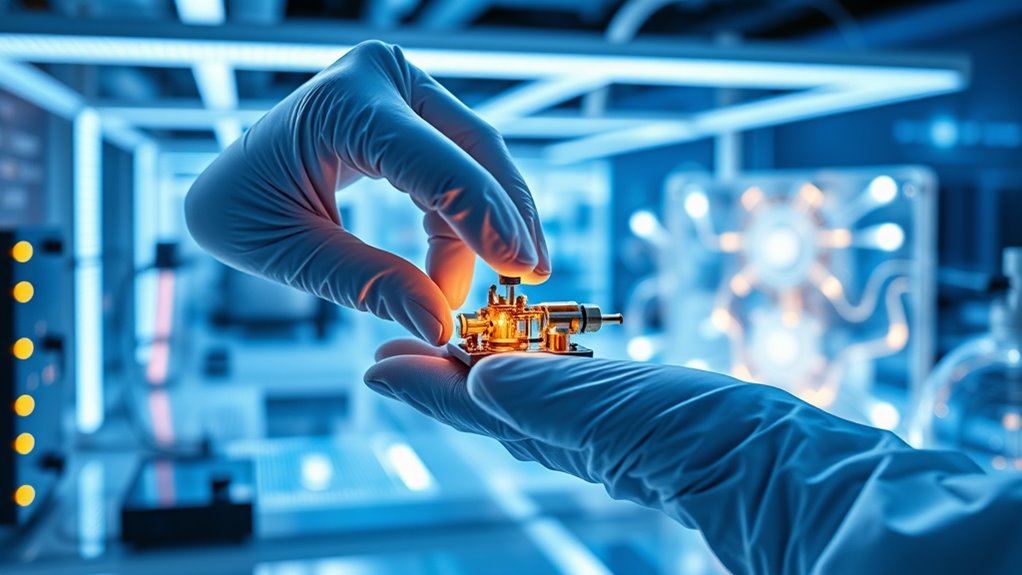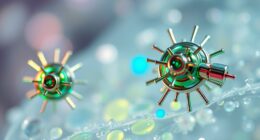Startups are revolutionizing energy by leveraging nanomachines and nanomaterials to enhance power generation, storage, and efficiency. They develop advanced solar panels with nanostructures that boost light absorption and create ultra-thin, flexible batteries suitable for wearables and drones. These innovations promote sustainability and reduce waste, transforming renewable energy systems. If you want to explore how these cutting-edge technologies are shaping a cleaner, more efficient energy future, there’s more to discover as you continue.
Key Takeaways
- Startups are developing nanomaterials to enhance photovoltaic efficiency, enabling more sustainable and lightweight solar energy solutions.
- Innovative nanomachine-based energy storage devices are creating flexible, ultra-thin batteries for wearables and portable tech.
- Companies focus on customizing nanomaterials to optimize energy conversion and storage, improving overall system performance.
- Nanotechnology startups are advancing renewable energy systems, making them more practical, efficient, and environmentally friendly alternatives to fossil fuels.
- These startups are driving commercialization of nanomachine applications that revolutionize energy generation, storage, and deployment worldwide.

In the domain of nanomaterial applications, startups are exploring materials that enhance the performance of existing energy systems. For example, incorporating nanostructured materials into photovoltaic panels can increase their light absorption, translating into higher energy output with less material. Similarly, nanomaterials are being used to create ultra-thin, flexible energy storage devices that fit into compact spaces without sacrificing capacity. These innovations allow you to deploy energy solutions in places previously considered impractical, like wearable devices or lightweight drones, expanding the reach and versatility of renewable energy sources. This focus on nanomaterial applications makes energy systems more adaptable, efficient, and sustainable, aligning with global efforts to reduce carbon footprints. Additionally, researchers are investigating how nanomaterial properties can be tailored to optimize energy conversion and storage processes further. This targeted approach is essential in pushing the boundaries of what renewable energy can achieve, making it a practical alternative to fossil fuels.
Frequently Asked Questions
How Do Nanomachines Improve Energy Efficiency?
Nanomachines improve energy efficiency by optimizing molecules involved in energy conversion processes, making them more effective. You can see how molecular optimization allows nanomachines to facilitate precise energy transfer, reducing waste and increasing output. This targeted approach means less energy is lost as heat, and more is converted into useful power. As a result, you benefit from cleaner, more efficient energy systems that save resources and reduce environmental impact.
What Are the Environmental Impacts of Nanomachine Energy Tech?
You might worry about environmental impacts, but nanomachine energy tech can reduce environmental degradation and resource depletion. It minimizes waste and uses fewer raw materials, which lessens pollution. However, you should also consider potential risks like nanomachine toxicity and long-term ecological effects. Overall, with proper regulation and development, this technology can promote a cleaner, more sustainable energy future while minimizing harmful environmental impacts.
Are Nanomachines Scalable for Large Energy Grids?
You might think big, but nanomachines face scalability challenges for large energy grids. Manufacturing hurdles, such as producing vast quantities with precision, slow down progress. While the technology shows promise, it’s not quite ready to take on massive energy demands. You’ll need to see advancements in manufacturing techniques and cost reductions before nanomachines can reliably power entire grids. Patience and innovation are key to turning this into reality.
What Safety Measures Are in Place for Nanomachine Deployment?
You should know that nanomachine regulation and safety protocols are strictly enforced during deployment. Regulatory agencies set standards to make certain of safe operation, including containment measures and real-time monitoring systems. These protocols help prevent accidents, unauthorized use, or environmental harm. Continuous oversight and rigorous testing are in place, giving you confidence that nanomachine deployment is managed responsibly, minimizing risks and ensuring safety for both people and the environment.
How Soon Will Nanomachine Technology Be Commercially Available?
Nanomachine technology is expected to become commercially available within the next 5 to 10 years. You’ll see rapid progress as nanomachine manufacturing advances and regulatory hurdles are addressed. Market adoption will depend on safety, cost, and proven efficiency. Keep an eye on startups and industry breakthroughs, because as these factors improve, nanomachines will increasingly transform energy sectors and other industries, making this technology accessible sooner than you might expect.
Conclusion
So, next time you flick on a light switch, remember that startups are crafting nanomachines so tiny they could fit inside a grain of rice—and yet, these innovations could power entire cities someday! It’s like we’re on the brink of a energy revolution so wild, it’ll make sci-fi look tame. Brace yourself, because nanomachines are about to turn your world upside down, making clean, limitless energy feel like just another everyday miracle.









